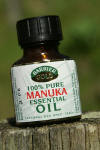21 October 2004
Manuka oil analysis from Malcolm Douglas
New crop Agronomist, NZ Institute for Crop & Food Research Limited
 Your
manuka leaf samples arrived in excellent condition and were distilled in
pairs, on the 20th and 21st September. Our laboratory stills take about a
kilogram of foliage, and we sub sample for dry matter and keep a herbarium
sample. The percentage dry matters for samples 1-4 were 57%, 58%, 70%, and
60% and the oil yields were 0.76 ml/100 g dry matter, 0.36 ml/100 g dry
matter, 0.26 ml/100 g dry matter, and 0.2 ml/100 g dry matter. We base the
results on a dry matter basis to avoid any difference caused by moisture
levels. The range in oil yield is typical for manuka.
Your
manuka leaf samples arrived in excellent condition and were distilled in
pairs, on the 20th and 21st September. Our laboratory stills take about a
kilogram of foliage, and we sub sample for dry matter and keep a herbarium
sample. The percentage dry matters for samples 1-4 were 57%, 58%, 70%, and
60% and the oil yields were 0.76 ml/100 g dry matter, 0.36 ml/100 g dry
matter, 0.26 ml/100 g dry matter, and 0.2 ml/100 g dry matter. We base the
results on a dry matter basis to avoid any difference caused by moisture
levels. The range in oil yield is typical for manuka.
Dr Noel Porter completed the analysis of the manuka samples.
A gas chromatograph measurement is based on the speed the
compounds move through the separation tube after injection into a hot gas
flow, and the most volatile and lightest compounds are fast movers while the
heavier compounds are the slowest. Noel has only identified 13 compounds,
which are about 53% of the total peak area. In the oil sample number 4, only
46% of the peak area has been identified and this has a compound peak of
4.6% at peak 56. This could be an elevated level of the biologically active
tri-ketone leptospermone and although low, this would be in keeping with our
national manuka survey results for the Auckland/Waikato area. Your results
fit with the close-by mainland samples of Cluster 3, which have elevated
levels of selinene and are low in monoterpenes. The selinenes have been
described as having mild, woody, warm, herbaceous peppery odour of excellent
tenacity for beta selinene and mild, sweet-woody, slightly peppery odour of
good tenacity for alpha selinene. I have been wondering how best to describe
your oil and something like - a complex mixture of sesquiterpene compounds
of green fresh aroma.
The comments Noel has detailed are - Although there are
some differences in the levels of some components, the basic pattern is very
similar, indicating a uniform genotype over the area from which these
samples were taken.
To my nose, the aroma is unusual but attractive for toiletry products
where the green, fresh notes should be useful.
A number of unknown compounds are present at much higher
levels than I have seen before and have made good separation by gas
chromatography very difficult. Although the separations are just adequate,
their presentation in the printout is not very clear because of the very
similar retention times.
The unusual green aroma note may arise from one or more of these
unknowns, which make up a significant proportion of the oil.